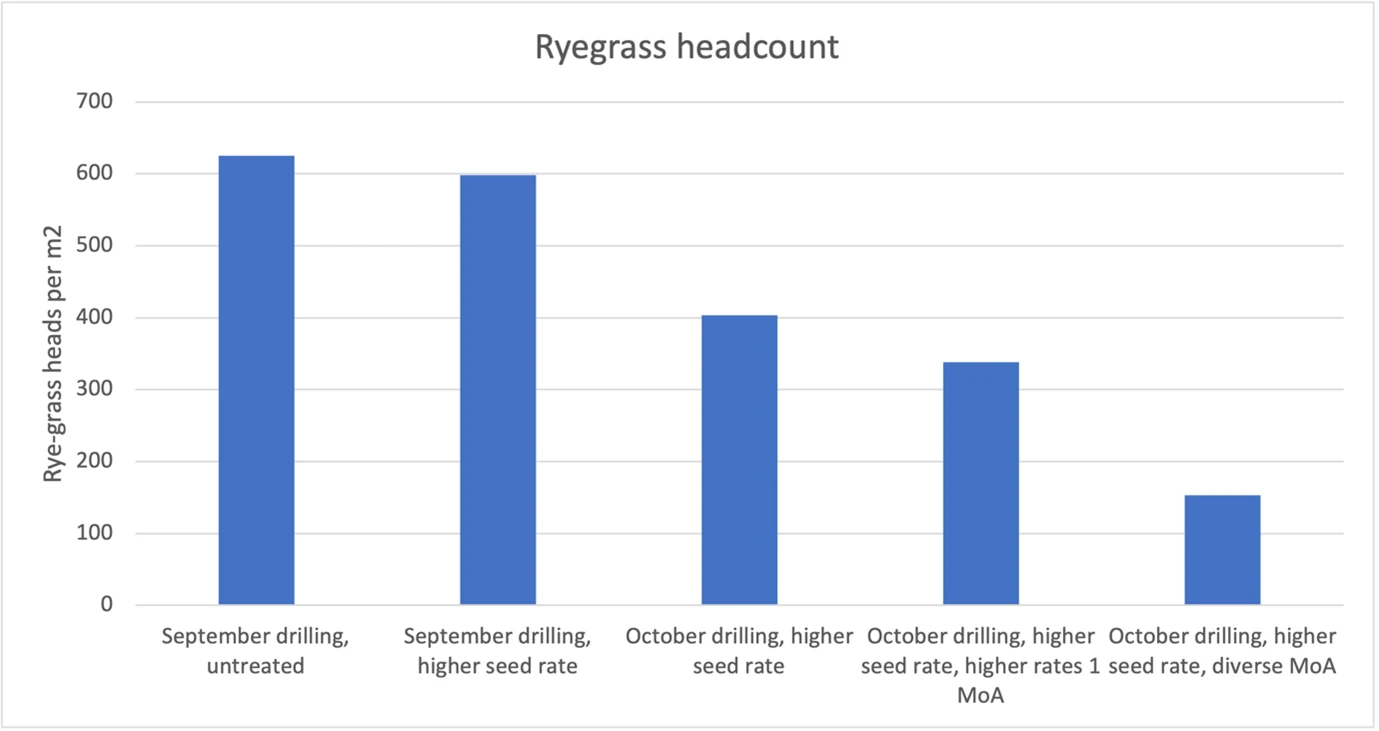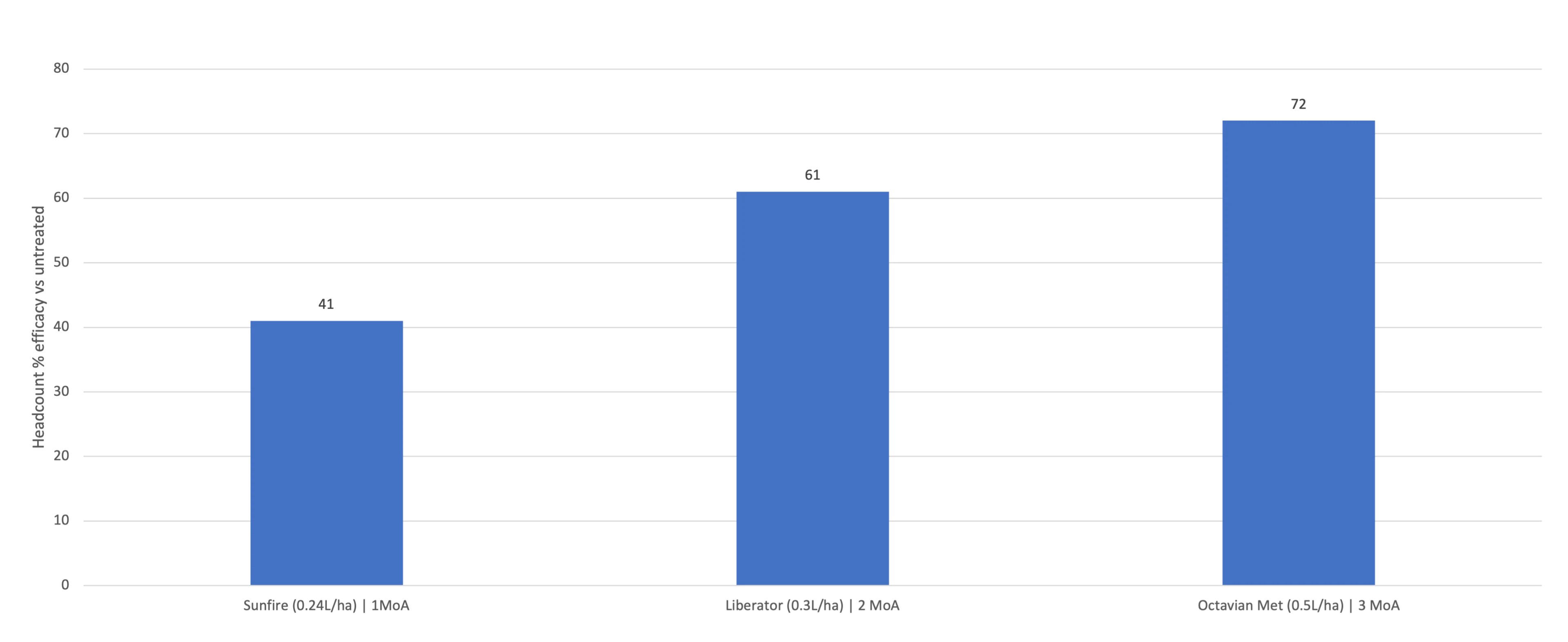
- Background of MoA trials
- Trial results
- Comparison with product trials
- Practical steps
Author
| 29th September 2023Tags
We Highly Recommend:
Herbicides
Liberator
Liberator is the first step to effective grass-weed and broad-leaved weed control in winter wheat, winter barley, spring wheat and spring barley.
Read moreHerbicides
Proclus®
A highly effective residual herbicide for the control of black grass, Italian rye-grass, brome and other grass weeds and broadleaf weed species. For use in winter wheat and winter barley.
Read morePractical benefits of mixing modes of action
Background of MoA trials
There are currently actives from six HRAC Mode of Action (MoA) Groups that farmers can use at pre-em and early post-em against black-grass and Italian ryegrass. A seventh, bixlozone from HRAC Group 13 is due in the near future, there is also glyphosate and post-em chemistry for other points in the programme.
Over the last decade, weed control has shifted to the pre-em timing often with a high loading of flufenacet used to improve control. But with a greater choice of actives now available, farmers should look to diversify MoA rather than increase the loading of one or two actives.
“We were interested in investigating the benefit of adding more MoA versus simply applying a higher total dose of herbicide,” says John Cussans. “Many trials done by manufacturers and distributors tend to look at products at full rate, which is how farmers use them and what we generally recommend for resistance management.”
“But such trials don’t really tell you if you get better control because you have diverse MoA, or the effect is from just applying more herbicide in total. We wanted to investigate this.”
NIAB set up a matrix trial with five pre-em MoA in total and the highest total loading was equivalent to five label rates of herbicide. Hence, at the lowest total dose, the trial compared the efficacy of one active applied at label rate compared to five actives in a stack at 1/5 of the label rate for each active. At the highest rate, a 5-times label rate of flufenacet (1200g/ha) was compared to five different actives all at the label rate.
The trial set up is different to the standard herbicide trial and includes application rates – high and low – that aren’t recommended for use on farm, but it does show how both factors of total dose and mode of action diversity affect control.
Trials results
“In year one of trial, we could see straightway that against Italian ryegrass, mode of action diversity is seen in improved efficacy, even at low dose rates. Whereas, against black-grass we see less direct benefit from more modes of action and greater rate responses.”
In year two, these results were repeated and once again the trend was more pronounced in Italian ryegrass than black-grass.
Graph: Mode of action diversity and ryegrass control

In practical terms it means that mode of action diversity is not just about long-term stewardship but about better short-term control too. In addition to chemical controls, you can also look at how cultural controls stack together to increase control.
The starting point was an untreated September drilled crop. Next, higher seed rates were tested, then October drilling and higher seed rates. Shifting to October drilling had a huge impact on overall control and showed that with high weed pressure situations it is very difficult for herbicides to recover the situation.
On top of the cultural controls, a single active programme was compared to diverse modes of action. Control from the diverse programme were far superior.
The results show the cumulative effect of stacking cultural controls and using a more diverse programme, several approaches can be stacked together to get the best possible control.

We Highly Recommend:
Herbicides
Liberator
Liberator is the first step to effective grass-weed and broad-leaved weed control in winter wheat, winter barley, spring wheat and spring barley.
Read moreHerbicides
Proclus®
A highly effective residual herbicide for the control of black grass, Italian rye-grass, brome and other grass weeds and broadleaf weed species. For use in winter wheat and winter barley.
Read moreComparison with product trials
As explained previously, in product trials it is hard to distinguish between the influence of MoA diversity and herbicide loading. Against both black-grass and ryegrass, the best control was achieved by Liberator + Proclus + prosulfocarb, averaging around 90% control of both weeds. Hence this mix is needed for high pressure situations.
In trials of peri-em top-up applications in black-grass and Italian ryegrass, the pattern of ryegrass having a more pronounced response to MoA diversity was repeated. In these trials, all crops received Liberator + Proclus at pre-em followed by varying peri-em application, the graphs below show efficacy of the peri-em only.
Against black-grass, using flufenacet at peri-em underpins additional control, adding further actives makes only relatively small incremental improvements.

For ryegrass control, each additional active provides a clear step up in control, 20% between straight flufenacet and Liberator and a further 11% for the addition of metribuzin and then pendimethalin bringing overall control to 83%. Remember this control would be on top of that achieved by the pre-em.

Practical steps
For farmers planning herbicide programmes, Jamie Oakley of Bayer has the following advice. “First of all, know what modes of action you are using and if the strategy isn’t diverse, make substitutions. HRAC Groups are a guide not a set of rules, in the UK, we tend to have non-target site metabolic resistance especially with regards to pre-em type chemistry. Cross-resistance is not easily predictable in this situation, but diverse programmes give the best chance of avoiding rapid development of resistance.”
“Using different chemistry also means diversity beyond mode of action, you will be using molecules with diverse chemical and physical properties like soil motility and sorption.”
“We are currently at the apex of herbicide availability, there are too many to use in one crop and it is quite easy to put together a diverse programme. You can even rotate actives between season, but that’s really putting the icing on the cake. I would prioritise stacking up non-chemical control, think about diversity beyond the herbicide portfolio.”
Summary
When you increase herbicide input across the programme, make sure they come from different families.
Aim to diversify MoA within season and between seasons, take note that some chemistry used in OSR, and beans comes from the same family as chemistry used in wheat.
You need diverse forms of control apart from chemistry. Weed control without a range of cultural controls will rapidly cause herbicide resistance.
Use different chemistry for ‘top-up’ applications than at pre-em. Focusing herbicide and active loading at pre-em typically achieves better control but be aware of conditions. For example, in a very dry autumn, apply more of the programme later on when soil is moister.
Make use of the actives while they are available, re-registration challenges and resistance mean that some actives will probably be lost in the years ahead.